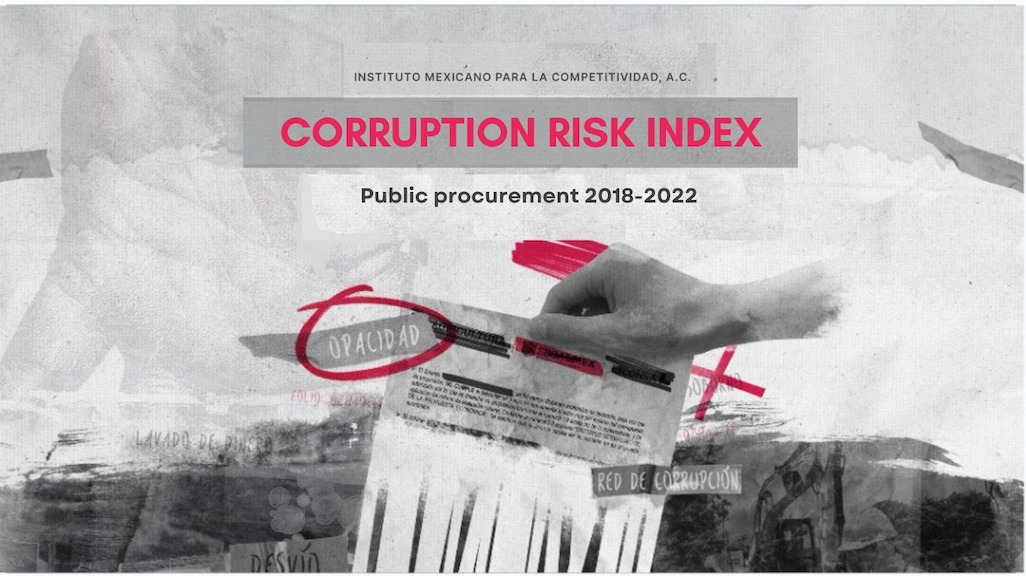
2023 Corruption Risk Index
- Between 2021 and 2022, the risks of corruption in federal public expenditures grew due to a lower level of competition, the lack of contract publications, and the delated register in Compranet
- In the 2023 Corruption Risk Index (IRC), 184 federal institutions (71%) increased their score.
- In 2022, federal institutions allocated 2.5 million pesos to ghost businesses, 107.868 million to penalized businesses, and 3.474 billion to newly incorporated businesses.
Public expenditures are fundamental for functioning government institutions and the supply of goods and services. Therefore, it is necessary to put conditions in place to assure the best possible price and quality. With the goal of analyzing the Federal Public Administration’s expenditures and identifying risky and corrupt practices, the Mexican Institute for Competitiveness (IMCO) introduces the new edition of the Corruption Risk Index (IRC), an innovative tool to make public policy decisions against corruption.
In 2022, public federal institutions carried out 174,219 purchases and spent more than 513 billion pesos. In general terms, seven out of every ten institutions increased their risk score in the IRC compared to 2021, which can be explained by public expenditure practices that hinder competitiveness, transparency, and compliance to the law.
Which risks are practiced in Federal Government expenditures?
- In 2022, 38% of the amount of public expenditures spent was directly allocated, and 25% of materialized competition had three or less participants. Mexico Biological Labs and Reactives (Birmex) spent 99% of the public expenditure amount through direct allocation and restricted invitations.
- 16% of direct allocations do not account for the contract document, and 30% of public bidding was incomplete. In other words, they failed to fulfill the publishing of one or more documents. Likewise, 4% of public expenditures do not take into account a functional group to Compranet, which impedes the spread of basic information in the process.
- 51% of 2022 public expenditures were published in Compranet after the start date. In fact, 10% of contracts were registered two months after starting.
Results of the 2023 Corruption Risk Index (2023)
-
- Between 2021 and 2022, the corruption risk in public expenditures increased in 184 of the 260 federal institutions (71%) and lowered in 76 (28%)
- Of the institutions that spent more than three billion pesos in expenditures (very high), Mexico Biological Labs and Reactives (Birmex) displayed a greater risk of corruption, with a score of 70 out of 100 points in the 2022 IRC, 26 points more than in 2021.
- The Salina Cruz comprehensive port administration was the institution with notably high spending that increased its risk score the most. It increased by 43 points compared to the previous year, above all due to the lack of competition in winery maintenance expenditures and the acquisition of western floodgate materials.
- The Communications and Transportation Ministry was the institution with notably high spending whose risk score was lower, which can be explained by the timely release and manner of recruitment in the Compranet platform.
- 74% of the amount spent in medicine was directly allocated. In 2022, the recruitment practices of the health sector were declared the least competitive. They highlight the cases of the National Health Institutes, particularly the Salvador Zubirán National Institute of Medical Science and Nutrition (INCMNSZ), the Luis Guillermo Ibarra Ibarra National Rehabilitation Institute (INR) and the National Institute of Genetic Medicine (INMEGEN) that received scores higher than 80 in the competitiveness subcategory index.
Public expenditures must be integrated in character. In other words, integrated by guaranteeing a high level of competitiveness, transparency, and law-compliance. As public institutions that join together the necessary factors to propel change in recruitment practices, the Ministry of Public Functions (SFP) must promote better conditions for the acquisition of goods and services and reduce risky practices in resource use. The transfer of Compranet to the SFP and the change to an updated version of the platform opens up opportunities for the oversight of public resources increasing its scope and effectiveness provided that the data results in understanding and actions. As such measures can support the achievement of this objective, IMCO proposes that:
- In order to strengthen the consolidated expenditure processes of medicine and pharmaceutical supplies so that planning is based on predictions of demand and frameworks that prioritize competition between providers.
- Reforming the Unique Providers and Recruiters Registry (RUPC) in order to achieve the task of putting useful information forward and appropriate it to recruiting institutions.
- Modifying the legal framework that allows institutions to fulfill direct allocations when having to do with goods and services geared towards direct marketing.
IMCO updated the public expenditures tool in Mexico. Refer to the competitive, transparent, and law-complying risk practices of each of the 260 federal institutions’ contracts between 2018 and 2022: https://imco.org.mx/riesgosdecorrupcion/.
